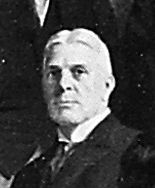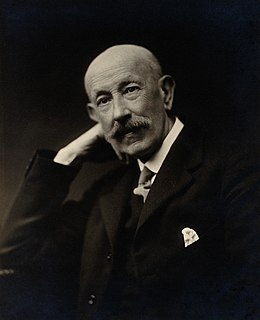
Sir Richard Quain, 1st Baronet, was an Irish physician.

Sir William Scovell Savory, 1st Baronet was a British surgeon.
Richard Quain was an English anatomist and surgeon, born at Fermoy, Ireland, a brother of Jones Quain. He studied medicine in London and in Paris. He was appointed demonstrator in 1828 and professor of anatomy in 1832 at the University of London, resigning in 1850, and assistant surgeon in 1834 and surgeon in 1848 to the North London Hospital, from which he resigned in 1866. He was president of the Royal College of Surgeons in 1868.

Francis Sibson FRS was an English physician and anatomist.

Sir Norman Moore, 1st Baronet FRCP was a British doctor and historian, best known for his work with the Royal College of Physicians and his writings on history of medicine. Born in Higher Broughton, Salford, Lancashire, the only child of abolitionist and social reformer Rebecca Moore, née Fisher, of Limerick and the noted Irish political economist Robert Ross Rowan Moore, Moore worked in a cotton mill before studying natural sciences in Cambridge and then going on to study comparative anatomy at St Bartholomew's Hospital.

Robert Marcus Gunn was a Scottish ophthalmologist remembered for Gunn's sign and the Marcus Gunn pupil.

Samuel Osborne Habershon was an English physician.

Arthur Farre FRS was an English obstetric physician.

Sir George Murray Humphry, FRS was a professor of physiology and anatomy at Cambridge, surgeon, gerontologist and medical writer.

John Syer Bristowe (1827–1895) was an English physician.
Dennis Embleton MRCS, FRCS, LSA, MD (Pisa) MD FRCP, was a Newcastle medical doctor and surgeon of the middle and late 19th century.

Sir Holburt Jacob Waring, 1st Baronet, CBE, FRCS was a surgeon at St Bartholomew's Hospital, London and was vice-chancellor of the University of London from 1922 to 1924.

Major-General Sir Anthony Alfred Bowlby, 1st Baronet was a British Army officer, surgeon and pathologist.
Joseph Frank Payne (1840–1910) was an English physician, known also as a historian of medicine.
James Goodhart (1845–1916) was an English physician whose work extended into various medical fields, including morbid pathology and paediatrics. He held positions in a number of London hospitals and institutions, including Guy’s Hospital and the Evelina Hospital for Sick Children. After his retirement, he set up in private practice in Portland Place, London. In 1911, Goodhart was awarded the baronetcy of Portland Place and Hoylte.

Walter Hamilton Hylton Jessop FRCS (1853–1917), Hunterian Professor of comparative anatomy and physiology (1887-8), Ophthalmic Surgeon, Senior Ophthalmic Surgeon to St Bartholomew's Hospital (1901), President of the Ophthalmological Society of the United Kingdom (1915–17) and someone who ‘made a unique position for himself in the ophthalmological world and was probably the best known of English ophthalmic surgeons to his brethren on the Continent of Europe’.
Timothy Holmes FRCS was an English surgeon, known as the editor of several editions of Gray's Anatomy.
J. Warrington Haward FRCS was an English surgeon, noteworthy as the last President of the Royal Medical and Chirurgical Society of London before it became expanded into the Royal Society of Medicine.

Sir Dyce Duckworth, 1st Baronet (1840–1928) was a British surgeon, physician, dermatologist, and author of A Treatise on Gout (1889), which was translated into French and German.

Sir Frederick William Andrewes was an English physician, pathologist, and bacteriologist.

















